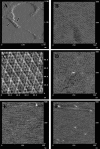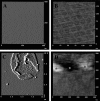Human monoclonal antiphospholipid antibodies disrupt the annexin A5 anticoagulant crystal shield on phospholipid bilayers: evidence from atomic force microscopy and functional assay
- PMID: 12937161
- PMCID: PMC1868273
- DOI: 10.1016/S0002-9440(10)63479-7
Human monoclonal antiphospholipid antibodies disrupt the annexin A5 anticoagulant crystal shield on phospholipid bilayers: evidence from atomic force microscopy and functional assay
Abstract
The antiphospholipid (aPL) syndrome is an autoimmune condition that is marked by recurrent pregnancy losses and/or systemic vascular thrombosis in patients who have antibodies against phospholipid/co-factor complexes. The mechanism(s) for pregnancy losses and thrombosis in this condition is (are) not known. Annexin A5 is a potent anticoagulant protein, expressed by placental trophoblasts and endothelial cells, that crystallizes over anionic phospholipids, shielding them from availability for coagulation reactions. We previously presented data supporting the hypothesis that aPL antibody-mediated disruption of the anticoagulant annexin A5 shield could be a thrombogenic mechanism in the aPL syndrome. However, this has remained a subject of controversy. We therefore used atomic force microscopy, a method previously used to study the crystallization of annexin A5, to image the effects of monoclonal human aPL antibodies on the crystal structure of the protein over phospholipid bilayers. In the presence of the aPL monoclonal antibodies (mAbs) and beta(2)-GPI, the major aPL co-factor, structures presumed to be aPL mAb-antigen complexes were associated with varying degrees of disruption to the annexin A5 crystallization pattern over the bilayer. In addition, measurements of prothrombinase activity on the phospholipid bilayers showed that the aPL mAbs reduced the anti-coagulant effect of annexin A5 and promoted thrombin generation. These data provide morphological evidence that support the hypothesis that aPL antibodies can disrupt annexin A5 binding to phospholipid membranes and permit increased generation of thrombin. The aPL antibody-mediated disruption of the annexin A5 anticoagulant shield may be an important prothrombotic mechanism in the aPL syndrome.
Figures






References
-
- Hughes GR: Hughes’ syndrome: the antiphospholipid syndrome. A historical view Lupus 1998, 7:S1-S4 - PubMed
-
- Rand JH: The antiphospholipid syndrome Annu Rev Med 2003, 54:409-424 - PubMed
-
- Rand JH: Molecular pathogenesis of the antiphospholipid syndrome Circ Res 2002, 90:29-37 - PubMed
-
- Funakoshi T, Heimark RL, Hendrickson LE, McMullen BA, Fujikawa K: Human placental anticoagulant protein: isolation and characterization Biochemistry 1987, 26:5572-5578 - PubMed
-
- Tait JF, Sakata M, McMullen BA, Miao CH, Funakoshi T, Hendrickson LE, Fujikawa K: Placental anticoagulant proteins: isolation and comparative characterization four members of the lipocortin family Biochemistry 1988, 27:6268-6276 - PubMed
Publication types
MeSH terms
Substances
Grants and funding
LinkOut - more resources
Full Text Sources
Other Literature Sources
Medical

